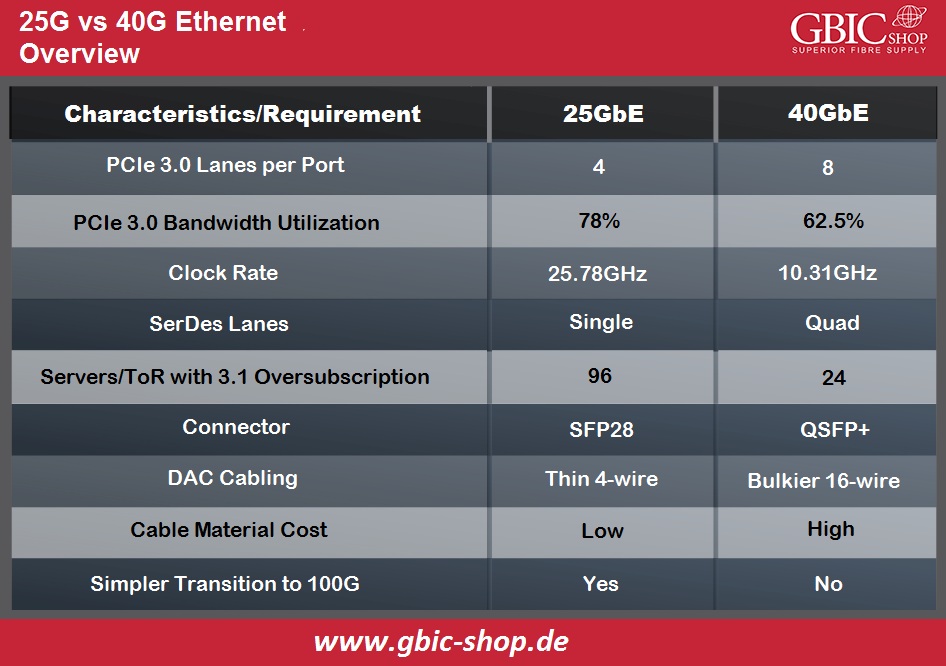Nowadays, high bandwidths are a constant pursuit of transmission service providers and cloud computing data centers, so the evolution of networks to 100 gigabit or even higher data rates is a necessary trend. Normally, we can achieve the transition to 100 Gigabit via two common paths, namely 10 Gigabit-25 Gigabit-100 Gigabit and 10 Gigabit-40 Gigabit-100 Gigabit. It looks like the key lies in the implementation of 25 Gigabit and 40 Gigabit, so how can we differentiate between the two? How can we choose between 25 Gigabit and 40 Gigabit Ethernet? This article compares them in terms of network, application, cabling and switch selection.
An analysis of 25 Gigabit and 40 Gigabit Ethernet:
IEEE 802.3 working groups 802.3 have developed 25 Gigabit Ethernet in 2014 to create the low bandwidths of 10 Gigabit and the high cost of 40 Gigabit. 25 Gigabit Ethernet only favors a track of 25 gigabytes per second with the exact size of both SFP+ and SFP. That is the communication capability of 10 Gigabit by 2.5 times, so IEEE has described 100 Gigabit Ethernet, and its base is on four 25 Gigabyte per second lanes. In addition, 25 Gigabit SFP-28 fiber optic transceivers can handle data rates of 28 Gigabytes per second. Compared to 40 Gigabit Ethernet, 25 Gigabit Ethernet also offers a high port density and a more cost-effective bandwidth per switch port unit. In recent years, 25 Gigabit products such as 25 Gigabit SFP-28 or 25 Gigabit switches, 25 Gigabit AOC and 25 Gigabit DAC cables have attracted a lot of attention, especially in 5G usage and cloud data centers, making the 25 GbE market a positive trend.
Prior to the development of 25G, 40GbE was the only available choice for high-speed connectivity as 40GbE contains four 10G lanes. The technology of 40G is more advanced than 25 Gigabit, resulting in the cost of 40 Gigabit products such as 40 Gigabit switches, 40 Gigabit QSFP+ optical transceivers, 40 Gigabit AOCs and 40 Gigabit DAC cables continuing to fall. However, the progress of 40 Gigabit is now encountering some problems, which include the impact of 100 Gigabit, as 40 Gigabit is not cost-effective or power-efficient in TOR switching for cloud computing providers.

Main factors for choosing between 25G and 40G:
Before deciding between 40G and 25G, we need to consider three key factors.
Application:
40 Gigabit, on the other hand, is intended for switch-to-switch deployments and helps reduce bottlenecks within the layer that causes a connection between distribution switches and data center access switches. We currently use 25G for server-to-switch applications, which offer higher speeds than 10 Gigabit and are the best cost-effective solution for expanding to 100 Gigabit and high data rates. If we significantly promote 25 Gigabit switch-to-switch connections, 25GbE can have a large market. In addition, 25 Gigabit optics are required to implement the 5G system, especially in the font-haul communication of 5G, reaching a new level of development. At the same time, 40 Gigabit is an optimal option for high-bandwidth connections, which is very efficient and more cost-effective than 100 Gigabit compared to 10G.
Switch options:
One element is the compatibility of the switches. As far as switch compatibility of 25G is concerned, it depends on the switch vendors. Only a few 25 Gigabit NICs and 25 Gigabit switches are backwards compatible with 10G, which increases the flexibility to manage a moderate migration to high speeds. However, as with an emerging technology, 25 Gigabit switches are more adaptable than 40 Gigabit switches, which are vendor dependent. The other element is system and port density. 25 Gigabit comes with one 25 Gigabit SerDes lane and offers higher network scalability and port density than 40 Gigabit, which includes four 10 Gigabit lanes. 25GbE is therefore cost-effective, offers higher bandwidth and requires less power. The table below describes the comparison between 40G and 25G Ethernet and different Ethernet types.
.jpg)
Cabling:
25 Gigabit Ethernet uses small form factor optical transceivers that enable fiber and copper connections. SFP 28 DAC/AOC cables are a very suitable and cost-effective solution; the transmission distance is limited. When upgrading from 10 Gigabit to 25 Gigabit, we can reuse current LC cabling due to the high adaptability of 25 Gigabit, avoiding complex and costly re-cabling. With 40GbE, on the other hand, optical QSFP+ transceivers with optical MPO/MTP cables are usually used for short transmission distances. However, these cables have twelve optical fibers inside, which cost more than LC optical fibers of 10 Gigabit. The unpleasant thing is that they are not compatible. We have to abandon and rewire cables, and upgrading from 10 Gigabit to 40 Gigabit is a significant expense.
.jpg)
Conclusion:
25 Gigabit and 40 Gigabit differ in various aspects, even though they both facilitate the development of the 100 Gigabit network. Normally we use 25 Gigabit for server-to-switch connections and 40 Gigabit mainly for switch-to-switch connections. The choice is easier for the current network conditions and mainly depends on the BV (business volume). For customers working towards a network evolution to 100 Gigabit or more excellent data rates, 25 Gigabit may be the best solution to utilize the current cabling for time and cost savings with good transmission efficiency.
 English
English
 Deutsch
Deutsch
 Espaniol
Espaniol










